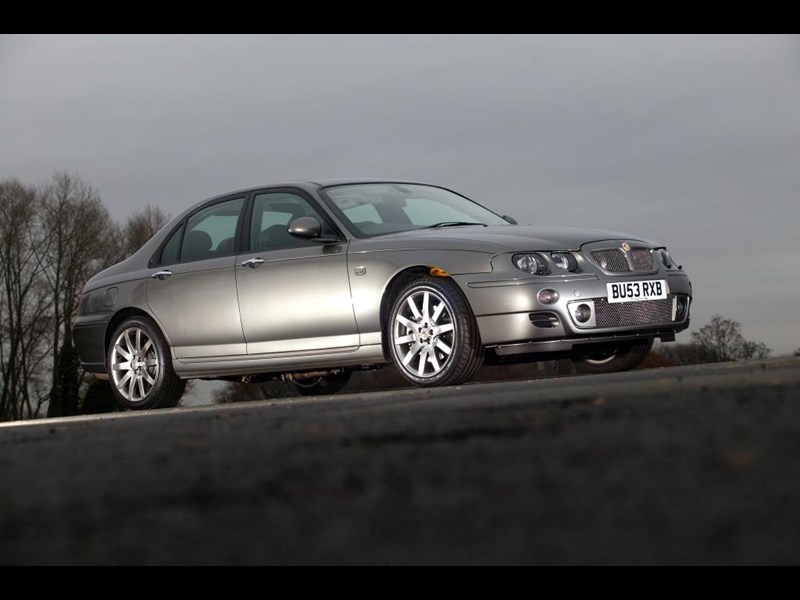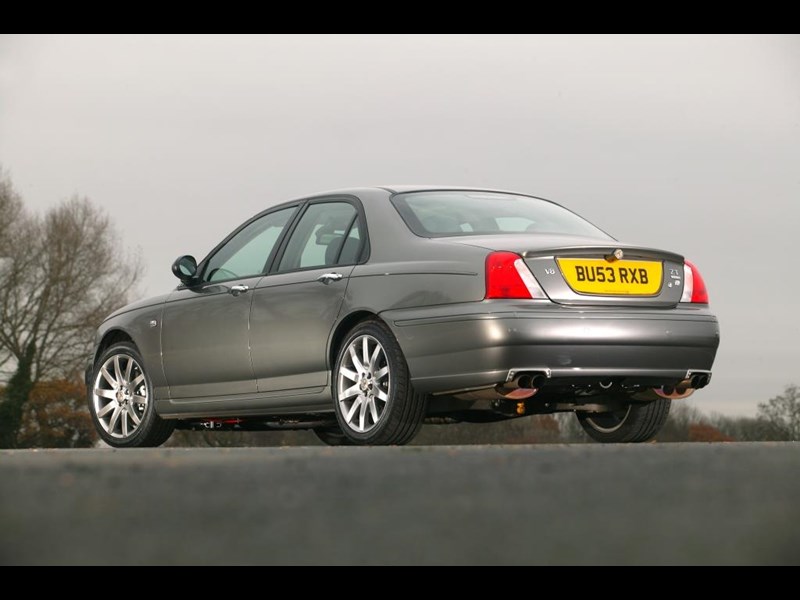From traditional charm to sporting saloon, there's a version to suit everyone as we turn the spotlight on Rover's last model and its potent MG sibling...
Launched in 1999, the Rover 75 was the company’s last hurrah before disappearing into a mire of recrimination and obscurity. And despite being somewhat unusual, boasting gently curving and rather genteel styling amid a sea of sharp-looking executive chargers, it was, and indeed still is, much admired by many enthusiasts. And in 2001, the company broadened the appeal still further by introducing the MG ZT which brought with it a smattering of sporting accoutrements, not to mention the delightfully bonkers V8 version with its American motor and rear-wheel drive. Opt for the 75, though, and what you got was a car that was just perfect for pottering to the golf club or swallowing up motorways with relaxed ease. Smooth riding and impressively refined, it might have lacked the image of rival saloons but there was little doubting its ability, and there was a wide choice of engines from punchy K-Series units to the slick KV6. Or for extra frugality, the BMW-sourced M47-R diesel was just the ticket boasting crisp throttle response and a relaxed, torquey power delivery. Inside, well it was no wonder that some commentators dubbed it a ‘baby Bentley’. Unashamedly retro in its styling, it was a feast of plush seat materials, glossy wood, and glorious cream-faced dials. In fact, it was a thoroughly pleasant place to spend time proving comfortable and well-equipped, especially if you plumped for the top-spec Connoisseur. A downside was the ultimate lack of passenger space, particularly for those relegated to the rear perches, but the spacious boot was some consolation. And speaking of space, there was also the option of a spacious estate, or ZT-T if it was wearing the MG octagon. The sporting variant arrived in 2001, and while not exactly extrovert in its appearance, did just enough to inject some sporting allure. With petrol (or from 2002, diesel) engines and stiffer suspension it bought British charm to the sporting saloon segment and was a secure and entertaining handler. Even more entertaining if the 4.6-litre Ford V8 was under the bonnet, stonking performance and a delicious exhaust burble just an ankle flex away.
VITAL STATISTICS
Rover 75 2.0 CDTi
Engine 1951cccc/4-cyl/DOHC
Power 133bhp@4000rpm
Torque 192lb ft@2000rpm
Top speed 120mph
0-60mph 11.3secs
Economy 48mpg
Gearbox 5-speed manual
WHAT TO LOOK FOR
Bodywork
The good news is that rust shouldn’t be an issue, although it’s worth checking for any bubbles that might have appeared as a result of damage or stone-chips. And look for the usual scrapes and scuffs on hard-used high-milers; items like bumpers are pricey, even second-hand, while various official body-kits were offered for the MGs, so check they are undamaged. One bodywork issue to consider, though, is blocked drain holes in the plenum chamber. It’s an easy fix, but water build-up can damage the engine ECU and pollen filter, with expensive consequences.
Watch also for broken bonnet cables, noisy boot locks, and water leaks from blocked sunroof drains and around the rear light lenses. Water getting into the boot can cause electronic gremlins, so check for damp. The tailgate on estate models featured a separately opening rear window, so it’s worth checking that the latch mechanism works and that water hasn’t been getting past the seals.
Engine
In various states of tune for the Rover and MG variants, petrol engines were 1.8-litre K-Series units in normally aspirated and turbocharged forms, and a smooth six-cylinder KV6. The former could suffer from head gasket issues at around 30,000 miles but it should have been sorted by now and shouldn’t recur if repaired properly. Turbos can suffer from split hoses, and there are reports of a dicky fuel pump causing starting issues, while air leaks from the inlet manifold gasket and a faulty Mass Airflow Sensor will cause running problems. Niggling sensor faults will bring up warning lights on the dash. The KV6 is a strong unit, but changing the cambelts at six years/90,000 miles is crucial as failure will wreck the engine - special tools are needed so check it’s been done. The thermostat housing can crack on these engines, too.
The 75’s common-rail 2.0-litre diesel, dubbed M47-R, is a BMW unit and was also added to the ZT range in 2002. It doesn’t suffer from any real problems although it’s worth listening for rattles indicating a stretched timing chain (it’s a major job to change) and poor running caused by a blocked EGR valve. Slightly less sensible, though, is the 4.6-litre Ford V8 fitted to the MG ZT 260. Driving the rear wheels, it makes a great noise and is plenty quick enough, and it’s a reliable lump, too, with parts easily available from specialists. A niche choice, it’s thirsty if provoked.
Transmission
The Getrag 5-speed manual gearbox is bullet-proof, as is the Tremec unit in the V8. Just listen out for a rattling Dual Mass Flywheel, issues with clutch hydraulics, and clutch wear on hard used examples as replacement is pricey. Jatco supplied the 5-speed automatic and it can suffer from occasional gear selection issues, courtesy of electronic glitches. Make sure it changes smoothly, and there are no dashboard warning lights. An oil change at around 60,000 miles will keep things healthy mechanically.
The handbrake can play up, thanks to a troublesome metal clip, although it’s a cheap fix, but otherwise the brakes and steering are mainly trouble-free. It’s worth checking the suspension for rattling drop links and broken springs, and noisy front strut top mounts. The rear bushes on front lower arms can split, with a specialist charging around £150 to sort both sides. Uneven rear tyre wear can also be an issue - some cars were misaligned from the factory - but an alignment check and adjustment will sort things.
INTERIOR
The cabin of a 75 is lovely, but it’s worth checking that lighter hues haven’t become shabby. Darker-trimmed MG’s fare better in this regard, but with either model you need to ensure that all the kit is working properly. Minor electrical niggles can afflict both models, and if the airbag warning light is showing it’s almost certainly a loose wiring connection beneath the front seats. Ensure, too, that both keys are provided as replacing them costs upwards of £150 with re-programming.
OUR VERDICT
It seems certain that future classic status beckons for these cars, and both offer plenty of charm and ability for not much money. A strong range of engines and trims are a plus, and the plentiful choice means there’s no need to get stuck with a duffer. For bargain luxury or sporting ability, these models certainly fit the bill.


